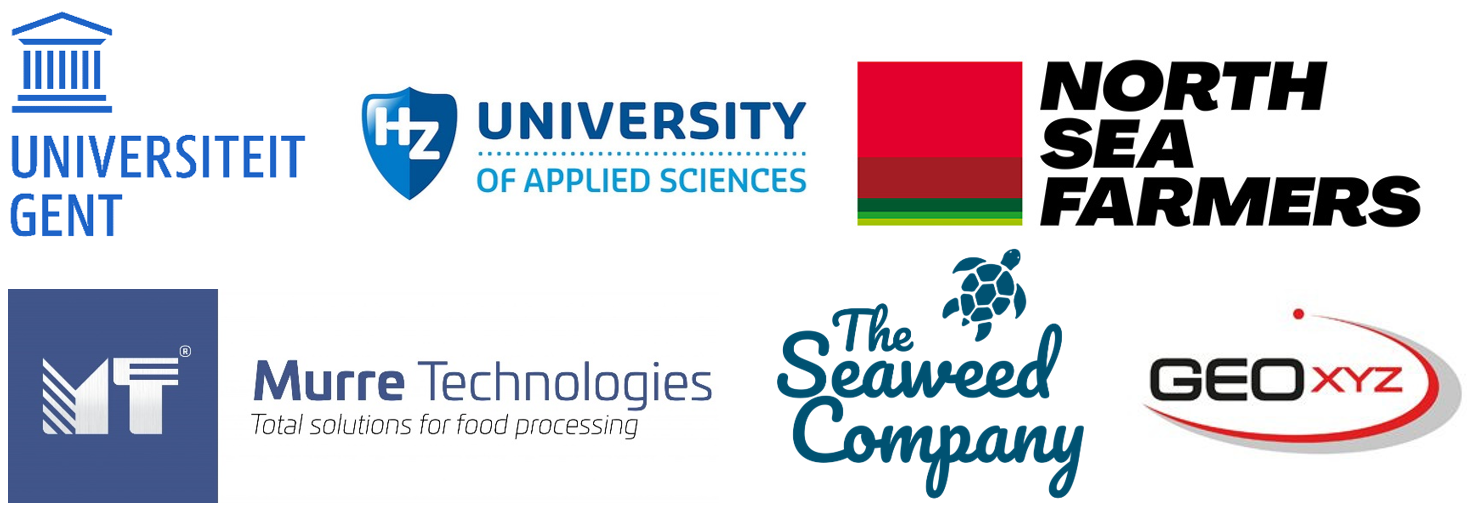
Why is this important?
Seaweed-based solutions can offer a valuable contribution in addressing today’s challenges such as climate change, food availability and finding alternatives to fossil-based value chains. To achieve this, the European seaweed sector needs to scale-up, and devise smart solutions to make the production process more efficient.
In recent years, many small seaweed growers have started leaarning to grow seaweed close to home, in the Flanders/ Netherlands border region. However, these sheltered/nearshore production sites are few in number and therefore scaling-up opportunties are limited. It is however required to generate large volumes to make positive impact.
That’s why this project tried to look how the prospect of scaling-up could be brought closer by exploring the technical and biological feasibility of seaweed production further offshore. Especially in the many existing and planned offshore wind farms there will be more than enough space to produce the required high volumes of seaweed. To this end, the Wier&Wind partners designed, built, installed and seeded a pilot seaweed farming system that was harvested with an innovative harvesting machine.
What were the objectives?
The aim of Wier&Wind was to develop a large-scale and automated seaweed production system, that is safe, sustainable and offshore-proof. A system that is reliable at sea and can be used within the many wind farms in the North Sea. Moreover, the system can be made economically viable by applying automation in order to reduce labour costs, increase offshore production speed and thus reducing vessel cost.
-
Mapping of preconditions for commercial seaweed cultivation in a wind farm and, where possible, filling in these preconditions with results from the project
-
Working towards the business plan that suits this commercial offshore seaweed farm situated in a wind farm
-
Increase awareness of offshore seaweed cultivation
-
Designing and developing a large-scale and automated seaweed production system that meets the offshore requirements and is suitable for functioning within wind farms
What did NSF do in this project?
North Sea Farmers are responsible for coordinating and conducting market research and various communication activities within the project. The market research focuses on the question: “How do we get the commercial seaweed farm in a wind farm in Flanders and in the Netherlands?”
NSF developed an
'investor roadmap' for the large-scale production of seaweed cultivation within wind farms. The communication activities serve to show all relevant stakeholders that concrete steps are being taken towards large-scale, sustainable and professional seaweed cultivation in the North Sea.
What Did the project looked like?
Installing the system:
The installation of the system at the
Offshore Test Site in February 2022 followed a week full of rough weather at sea. Finally, the conditions settled just enough to go out and perform the installation of the seaweed cultivation system and two innovative
eco-anchors.
The seaweed cultivation system mainly consisted of a 50m long, net-based system design that builds on experience from the mussel sector. For this pilot four different net structures have been integrated to test attachment strength of the seaweed on these different substrates, with different seeding techniques. This combination provided improved insight in the seeding & net combination.
Seeding:
For the project the seeding of the seaweed was performed onshore, at
Murre Technologies in Zeeland. Here the sporophytes and gametophytes were mixed with a specific glue. This mixture was put into a big tub and four different types of nets were taken through the seaweed mixture. In order to test the best way of seeding, sporo- and gametophytes and glue were also spray-painted to nets. About 30 meter of net were seeded with seaweed.
The nets were placed in different nurseries. Nearshore in the Oosterschelde, at a nursery tub at
Hogeschool Zeeland and at a nusery in Oostende. There the seedlings were able to initiate growth. At the start of 2022, the nets with seaweed were relocated to the
Offshore Test Site near Scheveningen.
Monitoring :
Every 6 weeks the length and width of the seaweed blades were measured on the cultivation site. The different nurseries and various net types led to a variety in seaweed growth during the experiment.
Harvest:
During Wier&Wind, the first automated harvesting operation ever, took place on the North Sea during this project. The fully automated harvesting machine was developed and built by project partner Murre Technologies, it was installed on the mussel ship YE32 and tested on the Offshore Test Site.
The ‘Easyfarm’ machine has a unique approach where it is lifted overboard and deployed over the operational seaweed growing system. This way, no removal or modification of the seaweed growing system is required making it a fast and controlled seaweed harvest operation.
The test demonstrated that the seaweed can indeed be successfully and swiftly harvested when the seaweed system is lifted just above the water line, whilst removing almost all of the seaweed and keeping this in good quality.
What were the results?
- The Wier&Wind project has led to a successful demonstration of the Wier&Wind seaweed farming concept.
- It showcased several seeding methods, seaweed cultivation
and growth on net-substates as well as mechanised harvesting of the produced seaweed.
- All in offshore conditions similar to the wind farms in the Dutch
and Belgian North Sea.
- A multi-use procedure for both the Dutch and Belgian parts of the North Sea
- The product brochure of Wier & Wind provides an overview of the project, as well as information for people who wants to start a seaweed farm.
Do you also want to start a seaweed farm in the North Sea?
Finance: €3.400.000 over a period of 3 years
Partners: 6 partners from Belgium and the Netherlands
Time: 07/2019 - 12/2022
Contact: Eef Brouwers




